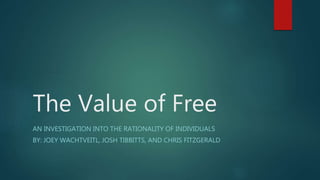The Value of Free
•Download as PPTX, PDF•
0 likes•113 views
This study investigated whether consumers place extra value on free goods compared to similarly priced goods. Researchers conducted a study with 12 replications where participants could purchase one of three types of chocolates (white, milk, or dark) at either $0.25 or $0.01, or $0.24 or free. An interaction between chocolate type and price would suggest consumers value free goods more. Analysis found a significant interaction, suggesting consumers do place extra value on free items over similarly priced items. This challenges the economic assumption that consumers always act rationally. However, the study had limitations like unequal variances and could be improved with more observations.
Report
Share
Report
Share

Recommended
More Related Content
Similar to The Value of Free
Similar to The Value of Free (20)
Week 3 Lecture 11 Regression Analysis Regression analy.docx

Week 3 Lecture 11 Regression Analysis Regression analy.docx
Week 5 Lecture 14 The Chi Square Test Quite often, pat.docx

Week 5 Lecture 14 The Chi Square Test Quite often, pat.docx
For this assignment, use the aschooltest.sav dataset.The d

For this assignment, use the aschooltest.sav dataset.The d
The Value of Free
- 1. The Value of Free AN INVESTIGATION INTO THE RATIONALITY OF INDIVIDUALS BY: JOEY WACHTVEITL, JOSH TIBBITTS, AND CHRIS FITZGERALD
- 2. Consumer Theory: Completeness Consumers reveal preferences through purchase habits Consumers prefer certain goods over others A > B, A < B, or B = A Our study challenges completeness in consumer theory
- 3. Study Design 12 replications 2 Factors: Chocolate and Price Chocolate: White Chocolate, Milk Chocolate, Dark Chocolate Prices: ($0.25, $0.01) and ($0.24, $0.00)
- 4. What is the Value of Free? If there is no interaction between type and price then there is no extra value for free goods. Conversely, if there is an interaction between factors, then there is an extra value for free goods. Ho: There is no interaction between the price and type of chocolates. Ha: There is an interaction between the price and type of chocolates.
- 5. Data Collection Each of us were randomly assigned a number between 1 – 3 and each combination 1 – 12. We used a random generator to then assign four of the combinations to each of us. Sold our chocolates at different locations across campus, 1 hour for each combination. Participants could only purchase one chocolate We had three different flavors (white, milk, dark) Two types, truffle and kiss Our response was the number chocolates purchased In total we had 144 people participate.
- 7. Design We decided to use a Randomized block design [2] Two way factorial for this experiment.
- 11. Inferential Statistics Continued leveneTest(choco$Sold, choco$Type, center = mean) Levene's Test for Homogeneity of Variance (center = mean) Df F value Pr(>F) group 1 0.1471 0.705 22 leveneTest(choco$Sold, choco$Price, center = mean) Levene's Test for Homogeneity of Variance (center = mean) Df F value Pr(>F) group 1 1.5409 0.2276 22 By these levene tests we fail to reject the null so the variances are not equal. We tried to do various transformations (log, sin, cos and inverse) none of them improved the variance issues. We decided to move forward and used a 0.01 level of significance for our tests
- 13. Inferential Statistics Continued Interaction Ho: There is no interaction between Price and Type Ha: There is an interaction Test Statistic F=9.430 Degrees of Freedom Num df=6 Den df=48 P-value =0.00659 Since the P-value is less than 0.05 so we would reject the null hypothesis Therefore, we have sufficient evidence that there is an interaction between type and price
- 14. Inferential Statistics Continued Based on the results we see that the only significance was with the interaction, which was what we were interested in so we were happy to see that.
- 15. Outcome Sufficient evidence suggests a difference in purchase ratios, with respect to price. Individuals place extra value on free items.
- 16. Implications on Economic Assumptions Fundamental assumption in economics are that individuals act rationally. With price difference of $0.24 for both price points, purchasing ratio’s should not change. Is the fundamental assumption incorrect?
- 17. Experiment Shortcomings We lack the ability to measure marginal utility for each consumer. The variances of high prices and low prices are unequal. A greater number of observations would improve our study.